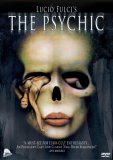As a woman commits suicide by leaping to her death on the English seacoast, her daughter in Italy has a vision of her fall. Years later, the now-grown Virginia (Jennifer O’Neill) is married to a wealthy businessman, and is suddenly plagued by visions again. Following the evidence, she discovers the skeleton of a young woman who has been walled up in her husband’s ancestral home for years. He is immediately arrested. Virginia works to prove his innocence by investigating the other mysteries of her visions, but she is letting herself in for more than she bargained for.
Having made quite a name for itself as a purveyor of lovely editions of classic European sexploitation, Severin branches out in spectacular fashion with this 1977 effort by Lucio Fulci. Fans of the director who know him exclusively for films such as Zombie and The Beyond will no doubt be disappointed by the lack of extreme gore. (Exception: the opening suicide, which delivers a nasty jolt as we see the woman’s face smash against the rocks as she falls. Unfortunately, Fulci has to show us the effect more than once, and it loses its effectiveness as its artificiality becomes clear.) But, as clearly derivative as it is of both Nicholas Roeg’s Don’t Look Now and Dario Argento’s Deep Red, this is still evidence that Fulci was more than capable of assembling a film that is gripping at the level of narrative and suspense. Unlike Don’t Look Now, where we are kept as much in the dark as its protagonist as to what the visions mean, here Fulci makes sure we are a few steps ahead of Virginia. We realize quite early that what she saw was a vision of the future, not the past, and watch helplessly as the strands of fate wind inexorably around her. There may not be much to her character, but her plight is so clearly articulated and so unstoppable that we cannot help but feel a soul-deep dread. A excellent slice of Eurohorror.
Audio
This is the one real problem with this release. The sound is damn near inaudible. I had to crank the sound to twice what my normal listening level would be just to get the dialogue and music to the point where they could be heard at all. And this meant that a background hiss became audible at the same time. Given that the post-synched cast is, with the exception of O’Neill, speaking with very thick Italian accents, it can be more than a little difficult to make out what is being said.
Video
The picture quality is much better. The print starts off in rather rough condition, with noticeable grain and dirt, and rather washed-out colours. After the credits, things begin to improve, and from that point on the picture gets better and better. The contrasts become stronger, the colours richer. The blacks look good, too. So most of the film looks very nice indeed.
Special Features
Along with the theatrical trailer is a featurette, “Voices from the Black,” which consists of audio interviews with co-writer Dardano Sacchetti, costume designer Massimo Lentini and editor Bruno Micheli, who all have quite detailed memories of the film shoot and what it was like to work with Fulci. A very nice little feature.
Closing Thoughts
Though the audio is a real problem, this should not discourage fans of Eurohorror in general, and Fulci in particular, from picking up this important release.






